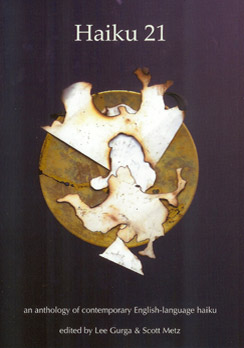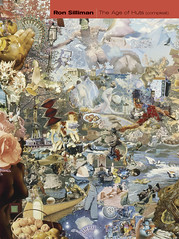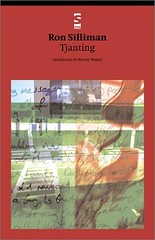Why would a poet who writes 1,000-page poems read haiku? Or pay heed to any manner of minimalism, for that matter? That’s a legitimate question, and one that I asked myself for at least a year before I felt that I fully understood my own personal answer. It’s because the questions of attention are so very similar. There is, in the minimalist poem generally, nowhere to hide. The poet’s attention – and hopefully the reader’s as well, though that’s a different discussion altogether – has to be utterly present. Every detail has to be attended. Individual letters & phonemes are revealed to have a beginning, a middle, and an end. In poems of ten or fourteen or thirty lines, of five pages or fifty, there are many opportunities for the poet’s mind to wander. Not that it needs to – what separates out, say, Frank O’Hara from Robert Lowell is not simply that the latter reads like the former under the influence of Quaaludes, but that O’Hara in his best poems is always fully present. The same is true for Robert Creeley or Philip Whalen or Allen Ginsberg or even Ezra Pound. At their best, they are fully present in the text. A poet like Lowell is far too often concerned about getting from point A to point B, formally or narratively, a concern that functions almost as a film of distraction over the writer’s capacity to observe & react. What drives me crazy about so much poetry, especially of the Quietist tradition, is just how damn slow it is, how long it takes to say or do anything. So when I come upon a poet who wastes nothing – Larry Eigner, Rae Armantrout, Ted Pearson, Joseph Massey, Mark Truscott – I feel more than just thrilled, I feel rescued. In contrast, I can’t even imagine staying awake for the time it takes to slog through many a half-page text by Seamus Heaney. If he’s not fully present in his own poem, why should I be?
But at a certain point in longer texts, I think the dynamics flip. In a poem like Zukofsky’s “A” or DuPlessis’ Drafts, the demands of scale are such that they require the writer to be consciously present. If you drift off in the long poem, you are apt to be gone for good. So the demand of the poem is to continually keep one’s attention present. Not the narrative present, which is something else altogether, but to the presentness of the text itself, in which the writer’s attention can only be characterized as self-aware. Mindful. Not that there aren’t degrees & kinds – Williams’ Paterson seems to me far weaker in just this regard than the shorter poems he wrote earlier, some of Olson’s Maximus is fully present, but not all of it; ditto Hart Crane’s The Bridge. The long poems of Theodore Enslin often strike me as one line after another demonstrating some small, acutely heard aural effect, the tone-leading of vowels, the wash of the softer consonants, but these lines also often strike me as being only that, as if this were the dimension of language to which Enslin was fully alive, the others – especially the more semantic aspects – left to fend for themselves.
But in the short poem – and I mean the seriously short poem – it’s be there or be square. And I think this ups the ante sufficiently so that one doesn’t need to be Shakespeare to respond to the challenge. Not that every short poem achieves this level of mindfulness, but a good percentage of them do.
So it’s not a surprise particularly to discover that there is a lot of excellent writing to be found in an anthology like Haiku 21: An Anthology of Contemporary English-Language Haiku, edited by Lee Gurga & Scott Metz, published by Modern Haiku Press of Lincoln, IL. It’s a fascinating, albeit problematic, collection. What’s problematic are the implications of its scale. The book includes, in a 205-page volume, just 153 of which are devoted directly to poetry, 212 poets and their works from the first decade of the present millennium. If you stop to consider just how badly Helen Vendler got her knickers into a twist over Rita Dove jamming 175 poets, representing an entire century, into 570 pages in her Penguin Anthology of 20th Century American Poetry, you can imagine what Vendler might think even if this weren’t the dreaded, debased, déclassé school of haiku. Tho if you will recall the larger kerfuffle that surrounded the Dove anthology, you will also remember that the more serious & thoughtful critiques were those that focused not on the numbers Dove included, but on the many more major American poets who got left out. At least one listserv generated a counter-table of contents that included 175 other poets whose work might have as easily been included. Few if any of the poets included in that listserv’s roster – and none of Dove’s 175 poets – appear in Haiku 21. Go figure.
If we take Vendler’s key challenge –
No century in the evolution of poetry in English ever had 175 poets worth reading, so why are we being asked to sample so many poets of little or no lasting value?
– as a serious question, it stands to reason that we should then be asking what it is about the 20th century that a poet as smart as Rita Dove would think it necessary to include as many writers as she did. I think the answer is fairly obvious: as the absolute number of publishing poets increases, the relationship between poet & audience is changing. There were only 8,000 English-language titles published in the US, of all kinds – not just poetry – in the late 1940s. Last year there was something like 1,000,000. Vendler’s howl is an attempt to preserve the social relations that governed the poet-publisher-university-audience network of the 1940s. Her complaint against Dove is rather like global warming denial – the longer you fail to recognize that it’s a new world, the sillier you’re going to seem, and the more damage you will actually do until then. Vendler’s article in the New York Review of Books is of value precisely because it reveals her as living in a world in which Edward R Murrow has yet to give way to Walter Cronkite.
If Vendler’s model of the poetry world, tho, is a Quietist coterie that hasn’t existed in real terms since Sylvia Plath died, haiku’s relation to that arcane fantasy has been as a nasty reminder that Vendler’s world – and that of quite a few other poets & critics, not all of them arch-conservatives – is hardly all that is the case. While English-language haiku has been a part of the larger writing scene since even before Ezra Pound’s “Station at the Metro,” (viz Sadakichi Hartmann & Rabindranath Tagore), and has been practiced off & on by several poets in the New American tradition – Cid Corman, Anselm Hollo, Jack Kerouac, Philip Whalen, Jonathan Williams, john martone, David Gitin, Jonathan Greene – the genre has more often been characterized as one populated by poets who might not otherwise read much contemporary poetry, who turn out large numbers of small poems, and aren’t particularly discriminating on the topic of quality, a poetics in which brevity is not synonymous with condensare. It’s worth noting how many of these same complaints are currently made about slam poetics, rap poetry, cowboy poetry, fisherman poetry (possibly the smallest self-contained genre in the US, practiced mostly off the coast of Oregon), military & prison poetry, wherever poetry is perceived as a populist activity, something anybody can do.
The degree to which this was ever really true about haiku is difficult to tell, although Haiku 21 makes clear that if it was, that was just the backwater of a much broader literary tradition, like the little Ginsbergs, Kerouacs, Bukowskis & Corsos one can still find in almost any urban area of the United States, still writing as if it were 1956. The reason I think it’s difficult to tell is that haiku’s use of kigo, the employment of a term that invokes a season (or, less often, a time of day), can be taken as a serious requirement of the form in its historic or traditional mode. To many Western readers, that comes off as a cliché & reads as excess, not as a mechanism for concentrating a lot of temporal or regional detail. Many of the poems in Haiku 21 make use of this device, some much more inventively than others.
into the afterlife red leaves
is a complete work by Peggy Willis Lyles and not atypical of a lot that has gone on in haiku in recent decades. There is no way of missing that this is an autumn poem, as traditional as haiku can be, whether or not you choose to pigeon-hole red as an instance of kigo. More significant is the fact that it’s a one-liner, which would be not at all atypical for Japanese haiku, but until recently was rare in English. This is an area in which non-haiku one-liners in the 1970s by poets like Robert Grenier & Aram Saroyan have actually had an impact far from the fields of the New York School or language poetry, empowering haiku to be more itself. The same is true for the absence of any verb here, tho it is worth noting that this device in American haiku is as old as “Station at the Metro.”
As more haiku poets became aware of other, sympatico modes of writing, the range of what’s possible has expanded. This is Haiku 21’s core message and one of the reasons no doubt that the two editors chose to focus on poems more than on poets. To an outsider, this may be most visible in the varieties of humor that abound in this book, some poking at haiku traditions per se, as in Ryan Underwood’s
One carp
the color of a woman;
an evening of snow
or (literally on the facing page) perhaps not, as in Mark Terrill’s
A road crosses a road another road does not.
Terrill’s is one of the rare haiku here that uses terminal punctuation. I’m not so sure how many semi-colons show up in this book either. Dashes & ellipses are the most common modes of punctuation.
But, and this may be the oddest feature of the collection, what none of the 600+ poems here seem to have is a title. If haiku as a genre is going through a period of opening up (not unlike how the sonnet opened up after Ted Berrigan got his hands on the form), that one rule should become so dominant makes my brow furrow. It’s true, no doubt, that a title functions as an extra – and often decisive – move. Consider “Station at the Metro” without that title. Yet it seems inconceivable to me that none of the 212 poets here can’t be doing something of interest with that big blank space above the body of the text.
Some of the poems here, such as Marlene Mountain’s
out of nowhere isn’t
are as good as anything I’ve read this century, regardless of genre. But, as is somewhat often the case in this collection, that poem becomes smaller & less interesting the longer you consider it, the instant you realize that it’s not the fragment it first promises.
Mountain is one of two dozen poets accorded at least two pages – with anywhere between 3 and 6 poems to a page – around which this book is really constructed. Thirteen poets have three or more pages, including the editors, Mountain, Willis Lyles, Fay Aoyagi, Jason Sanford Brown, Chris Gordon, Jim Kacian, john martone, Paul Pflueger, Jr, Philip Rowland, John Stevenson & Peter Yorvu. If, in fact, one wanted to construct an anthology that articulated the broader arc of work of “major practitioners,” the resources for such seem clearly to be in place, even though I think such a production would still be apt to give Vendler the willies. And it’s interesting to ponder what it means for a major tributary of American poetics to function so completely as tho it were a self-functioning phenomenon, a world of writing in itself, but close to unknown to the wider universe of letters.
Jim Kacian is a case in point. A major figure as a poet, but also as a publisher (Red Moon Press) and institutional promoter of haiku (The Haiku Foundation), Kacian started as a small press poet who went to Nashville to make music & didn’t get around to haiku until he made his way back to his adopted state of Virginia in the mid-1980s. In the world of haiku, he’s significant enough to have warranted a collection long after: Raccolta di haiku, published in Italy, in which Kacian’s haiku are translated both into German & Italian, with an introduction by Richard Gilbert, the godfather of contemporary Anglophone haiku theory & critique. Plus blurbs by John Stevenson and Roberta Beary (whose volume The Unbroken Necklace readers may recall I listed as one of two finalists when I picked the William Carlos Williams award in 2008).
Tho Gilbert writes that
These seven cycles of 17 haiku present an extension of the lineage of that genre which began with the Imagists and runs through Stevens and Williams, Eluard and Paz, and incorporates both the Beats and the Language poets, while cognizant of the century-old with the Japanese tradition, ancient and modern,
I read Kacian as fairly mainstream for American haiku, mostly focusing on the traditional three-line form, tho abandoning syllabic counting in favor of semantic impact –
without thinking
making love
during the hurricane
or
feverish
I dream a color
that does not exist
Kacian also makes use of the one-line mode:
flurries after our argument the need to tell you
or
still having to say the words out loud loneliness
long after solves one of the challenges in haiku – how to build something as substantial as a book from such a short form – by running the translations first in Italian (by Alessandra Gallo, Antonella Filippi & Pietro Tartamella, all of Cascina Macondo), then in German (by Dietmar Tauchner, Ruth Franke & Peter Meister) on each page (also three versions of the author’s note, Gilbert’s introduction and an acknowledgements page). Thus a volume that could have been printed monolingually at 60 pages comes in just under 180. It’s a creative resolution to a problem that reveals one of haiku’s most interesting features – that its relation to the form of the book is inherently uneasy. The practice of the poem – and I can’t think of a haiku author for whom this isn’t true – comes very much out of the individual’s daily living in the world. Books are inherently objects of commerce. This accounts in part for why so many of those late lamented independent bookstores were abject failures at marketing and selling poetry. And it reminds me of Charles Bernstein’s observation that a blank piece of paper loses value when a poem is printed on it.
john martone’s Ksana, published by Kacian’s Red Moon Press in ought nine (tho mysteriously unrepresented on the Red Moon website) is in many ways the best vindication this mode of minimalism might have – a big honking collection of great work. Ksana also demonstrates the relationship between the form & the life in that it brings together 20 small chapbooks that martone self-published over a four-year period. But to call Ksana a collection of haiku is almost a misnomer, not just because martone employs other short forms as well – he’s almost certainly the poet in Haiku 21 known most widely outside of the 17-syllable demi-monde – but because his style of scattering the poems around the page in formats that both preserve their haiku-ness while suggesting that these poems are not necessarily closed off one from the other, generating palimpsests of textuality. Imagine Larry Eigner’s short pieces merging into an almost Whalenesque kind of ongoing mind-movie & you’re not far off from martone’s world. And, as the names Whalen & Eigner should make clear, you’re in the territory of some significant writing & intense pleasure.
As best I understand it, Ksana means a “favorable moment,” the term moment here suggesting something almost instantaneous, and one might think of each work on any of martone’s pages in just such a fashion, some of which look decidedly unhaiku-like:
as
many
syl
lables
as
creatures—
ea
one in
turn—
once
a
gain
The form patently invokes Robert Creeley, right down to that pun on the last syllable, in a context here that shows just how Creeley’s more radical work (say, in Pieces) comes right to the edge of what I seem to keep calling the haiku world or realm. The choice to drop the ch from each in the fourth stanza is something martone does on several occasions, again positioning him within the tradition of flexible spelling & punctuation a la Pound & Olson.
Part of me wants to characterize Ksana as being an On Bear’s Head moment, not unlike the great fat collection of Phil Whalen’s that has been a secret staple of so many poets’ personal libraries for the past 43 years – and if martone’s book were twice its size here I don’t think there’d be any question of its having that magnum opus effect. As it is, it’s a step on that path, albeit one that might be hard to come by. Not only is it not listed on the Red Moon press site, but I couldn’t find a single copy available on AbeBooks.com. Nonetheless, you need to buy this book, to read it cover to cover & “grok” it in the very best sense of that verb.
Even if (maybe especially if) you’re writing 1,000-page poems.








